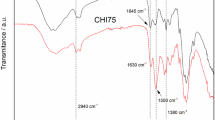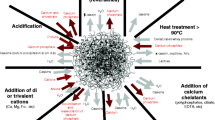Purpose
The purpose of this study was to elucidate whether the degradation rate of insulin in lyophilized formulations is determined by matrix mobility, as reflected in glass transition temperature (Tg), or by β-relaxation, as reflected in rotating-frame spin-lattice relaxation time \({\left( {T_{{1{\text{ $ \rho $ }}}} } \right)}\).
Methods
The storage stability of insulin lyophilized with dextran was investigated at various relative humidities (RH; 12–60%) and temperatures (40–90°C) and was compared with previously reported data for insulin lyophilized with trehalose. Insulin degradation was monitored by reverse-phase high-performance liquid chromatography. Furthermore, the \({\left( {T_{{1{\text{ $ \rho $ }}}} } \right)}\)of the insulin carbonyl carbon in the lyophilized insulin–dextran and insulin–trehalose systems was measured at 25°C by 13C solid-state NMR, and the effect of trehalose and dextran on \({\left( {T_{{1{\text{ $ \rho $ }}}} } \right)}\)was compared at various humidities.
Results
The degradation rate of insulin lyophilized with dextran was not significantly affected by the Tg of the matrix, even at low humidity (12% RH), in contrast to that of insulin lyophilized with trehalose. The insulin–dextran system exhibited a substantially greater degradation rate than the insulin–trehalose system at a given temperature below the Tg. The difference in degradation rate between the insulin–dextran and insulin–trehalose systems observed at 12% RH was eliminated at 43% RH. In addition, the \({\left( {T_{{1{\text{ $ \rho $ }}}} } \right)}\)of the insulin carbonyl carbon at low humidity (12% RH) was prolonged by the addition of trehalose, but not by the addition of dextran. This difference was eliminated at 23% RH, at which point the solid remained in the glassy state. These findings suggest that the β-relaxation of insulin is inhibited by trehalose at low humidity, presumably as a result of insulin–trehalose interaction, and thus becomes a rate determinant. In contrast, dextran, whose ability to interact with insulin is thought to be less than that of trehalose, did not inhibit the β-relaxation of insulin, and thus, the chemical activational barrier (activation energy) rather than β-relaxation becomes the major rate determinant.
Conclusions
β-Relaxation rather than matrix mobility seems to be more important in determining the stability of insulin in the glassy state in lyophilized formulations containing trehalose and dextran.





Similar content being viewed by others
References
M. J. Pikal (2002) Chemistry in solid amorphous matrices: implication for biostabilization H. Levine (Eds) Amorphous Food and Pharmaceutical Systems Royal Society of Chemistry Cambridge, UK 257–272
Y. Guo S. R. Byrn G. Zografi (2000) ArticleTitlePhysical characteristics and chemical degradation of amorphous quinapril hydrochloride. J. Pharm. Sci. 89 128–143 Occurrence Handle10664545 Occurrence Handle1:CAS:528:DC%2BD3cXit1eisLc%3D Occurrence Handle10.1002/(SICI)1520-6017(200001)89:1<128::AID-JPS13>3.0.CO;2-Z
S. Yoshioka Y. Aso S. Kojima (2004) ArticleTitleTemperature- and glass transition temperature-dependence of bimolecular reaction rates in lyophilized formulations described by the Adam-Gibbs-Vogel equation J. Pharm. Sci. 93 1062–1069 Occurrence Handle14999742 Occurrence Handle1:CAS:528:DC%2BD2cXivF2lt78%3D Occurrence Handle10.1002/jps.20022
S. P. Duddu G. Zhang P. R. Monte ParticleDal (1997) ArticleTitleThe relationship between protein aggregation and molecular mobility below the glass transition temperature of lyophilized formulations containing a monoclonal antibody Pharm. Res. 14 596–600 Occurrence Handle9165529 Occurrence Handle1:CAS:528:DyaK2sXjtlSks78%3D Occurrence Handle10.1023/A:1012196826905
M. J. Pikal (2004) Mechanisms of protein stabilization during freeze-drying and storage: The relative importance of thermodynamic stabilization and glassy state relaxation dynamics L. Rey J. C. May (Eds) Freeze-Drying/Lyophilization of Pharmaceutical and Biological Products Marcel Dekker New York 63–107
S. Rossi M. P. Buera S. Moreno J. Chirife (1997) ArticleTitleStabilization of the restriction enzyme EcoRI dried with trehalose and other selected glass-forming solutes Biotechnol. Prog. 13 609–616 Occurrence Handle9336981 Occurrence Handle1:CAS:528:DyaK2sXmsFWjtLo%3D Occurrence Handle10.1021/bp970061+
C. Schebor L. Burin M. P. Buera J. M. Aguilera J. Chirife (1997) ArticleTitleGlassy state and thermal inactivation of invertase and lactase in dried amorphous matrices Biotechnol. Prog. 13 857–863 Occurrence Handle9413144 Occurrence Handle1:CAS:528:DyaK2sXnt1Sht74%3D Occurrence Handle10.1021/bp970093x
Y. Chen J. L. Aull L. N. Bell (1999) ArticleTitleInvertase storage stability and sucrose hydrolysis in solids as affected by water activity and glass transition J. Agric. Food Chem. 47 504–509 Occurrence Handle10563924 Occurrence Handle1:CAS:528:DyaK1cXotFaitbY%3D Occurrence Handle10.1021/jf9807216
T. R. Noel R. Parker S. G. Ring (2000) ArticleTitleEffect of molecular structure and water content on the dielectric relaxation behaviour of amorphous low molecular weight carbohydrates above and below their glass transition Carbohydr. Res. 329 839–845 Occurrence Handle11125826 Occurrence Handle1:CAS:528:DC%2BD3cXptVWksLY%3D Occurrence Handle10.1016/S0008-6215(00)00227-5
S. Yoshioka Y. Aso (2005) ArticleTitleA quantitative assessment of the significance of molecular mobility as a determinant for the stability of lyophilized insulin formulations Pharm. Res. 22 1358–1364 Occurrence Handle16078146 Occurrence Handle1:CAS:528:DC%2BD2MXmvFWitro%3D Occurrence Handle10.1007/s11095-005-5262-z
T. C. Farrar E. D. Becker (1971) Pulse and Fourier Transform NMR, Introduction to Theory and Methods Academic New York
R. T. Darrington B. D. Anderson (1994) ArticleTitleThe role of intramolecular nucleophilic catalysis and the effects of self-association on the deamidation of human insulin at low pH Pharm. Res. 11 784–793 Occurrence Handle7937515 Occurrence Handle1:CAS:528:DyaK2cXlslSqtb4%3D Occurrence Handle10.1023/A:1018909220255
S. Yoshioka and Y. Aso. Negligible contribution of molecular mobility to the degradation rate of insulin lyophilized with poly(vinylpyrrolidone). J. Pharm. Sci. (2006), in press.
R. T. Darrington B. D. Anderson (1995) ArticleTitleEffect of insulin concentration and self-association on the partitioning of its A-21 cyclic anhydride intermediate to desamido insulin and covalent dimer Pharm. Res. 12 1077–1084 Occurrence Handle7494806 Occurrence Handle1:CAS:528:DyaK2MXmvFCks7Y%3D Occurrence Handle10.1023/A:1016231019677
R. G. Strickley B. D. Anderson (1997) ArticleTitleSolid-state stability of human insulin. II. Effect of water on reactive intermediate partitioning in lyophiles from pH 2–5 solutions: stabilization against covalent dimer formation J. Pharm. Sci. 86 645–653 Occurrence Handle9188045 Occurrence Handle1:CAS:528:DyaK2sXjtVOqt7Y%3D Occurrence Handle10.1021/js9700311
M. Karel I. Saguy (1991) ArticleTitleEffects of water on diffusion in food systems Adv. Exp. Med. Biol. 302 157–173 Occurrence Handle1746325 Occurrence Handle1:CAS:528:DyaK38XitFejs7o%3D
G. R. Moran K. R. Jeffrey J. M. Thomas J. R. Stevens (2000) ArticleTitleA dielectric analysis of liquid and glassy solid glucose/water solutions Carbohydr. Res. 328 573–584 Occurrence Handle11093713 Occurrence Handle1:CAS:528:DC%2BD3cXnsFKhsrk%3D Occurrence Handle10.1016/S0008-6215(00)00125-7
S. Yoshioka Y. Aso (2005) ArticleTitleGlass transition-related changes in moecular mobility below glass transition temperature of freeze-dried formulations, as measured by dielectric spectroscopy and solid state nuclear magnetic resonance J. Pharm. Sci. 94 275–287 Occurrence Handle15570601 Occurrence Handle1:CAS:528:DC%2BD2MXhtFOltrg%3D Occurrence Handle10.1002/jps.20244
S. Yoshioka Y. Aso S. Kojima S. Sakurai T. Fujiwara H. Akutsu (1999) ArticleTitleMolecular mobility of protein in lyophilized formulations linked to the molecular mobility of polymer excipients, as determined by high resolution 13C solid-state NMR Pharm. Res. 16 1621–1625 Occurrence Handle10554107 Occurrence Handle1:CAS:528:DyaK1MXntVOhurk%3D Occurrence Handle10.1023/A:1018973125010
Author information
Authors and Affiliations
Corresponding author
Rights and permissions
About this article
Cite this article
Yoshioka, S., Miyazaki, T. & Aso, Y. β-Relaxation of Insulin Molecule in Lyophilized Formulations Containing Trehalose or Dextran as a Determinant of Chemical Reactivity. Pharm Res 23, 961–966 (2006). https://doi.org/10.1007/s11095-006-9907-3
Received:
Accepted:
Published:
Issue Date:
DOI: https://doi.org/10.1007/s11095-006-9907-3




